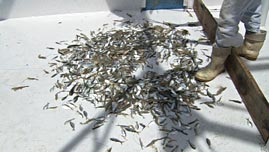Teachers' Domain - Digital Media for the Classroom and Professional Development
User: Preview

Source: "Big River"
In this video segment adapted from the independent film Big River: A King Corn Companion, the filmmakers explain how agricultural runoff from the Midwest has contributed to a massive "dead zone" in the Gulf of Mexico. A cornfield treated with conventional chemical fertilizer promises a bumper crop, but chemical runoff from the farm enters the Iowa River, eventually draining into the Mississippi River and the Gulf of Mexico. In the Gulf, these dissolved nutrients allow algae to flourish. The algae's decay depletes the water of oxygen, creating a dead zone where shrimp and fish are starved of oxygen and die.
Industrial agriculture in America supplies cheap and abundant food, but it is also a leading source of water pollution. Synthetic fertilizer, particularly nitrogen and phosphorous, have gained attention for their contribution to aquatic "dead zones" where fish, crabs, and other marine life die from lack of oxygen. While scientists have discovered about 400 dead zones around the world, the Gulf of Mexico dead zone is of particular concern because it threatens Gulf fisheries, which generate billions of dollars each year.
The problem begins on midwestern farms, where plants like corn, wheat, and soybeans need nitrogen and phosphorous to thrive. Intensive crop planting on these farms uses up the nutrients in the soil, and farmers replace them with fertilizer. Unfortunately, fertilizer doesn't always stay on the farm. Forty-one percent of the continental United States drains into the Mississippi River, and the majority of that soil is farmland. In peak growing season, about 8 million pounds of nitrate flows off farms and into the Mississippi River every day.
As the Mississippi and other rivers flow into the Gulf of Mexico, they carry about 1.7 million tons of nitrogen and phosphorous every year. These nutrients fuel the rapid growth of algae and plankton in the Gulf. Huge populations of these organisms grow, die, and sink to the bottom, their decay robbing the water of oxygen. The water at the bottom of the Gulf becomes oxygen deficient, or hypoxic, killing plants, fish, and other marine life. To make matters worse, the water in the Gulf is layered, with lighter, warmer, freshwater floating on top, and colder, denser, saltwater on the bottom. The layers do not easily mix, trapping the oxygen-poor water on the bottom.
Luckily, dead zones can be reversed. The Black Sea dead zone saw significant improvement in the years following the collapse of the Soviet Union, at which time fertilizers became costly. The size of the Gulf of Mexico dead zone varies each year, but at its peak it usually covers about 7,000 square miles, an area as large as New Jersey. The federal government aims to reduce the Gulf of Mexico dead zone to 2,000 square miles or less by 2015. Approximately two-thirds of the nitrogen in the Mississippi River comes from fertilizers used in agriculture. According to the U.S. Department of Agriculture, the best way to solve this problem is to use less fertilizer and manage it better on farms. Unfortunately, alternatives to commercial fertilizer, like animal manure, also contribute to water pollution and the hypoxia in the Gulf. With incentives from the federal government, U.S. farmers are now using filters, buffers, and wetland filtration to reduce fertilizer runoff and water pollution.
 Loading Standards
Loading Standards Teachers' Domain is proud to be a Pathways portal to the National Science Digital Library.
Teachers' Domain is proud to be a Pathways portal to the National Science Digital Library.
